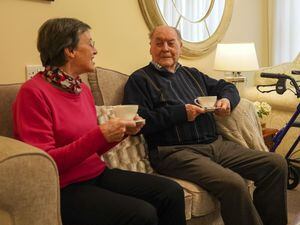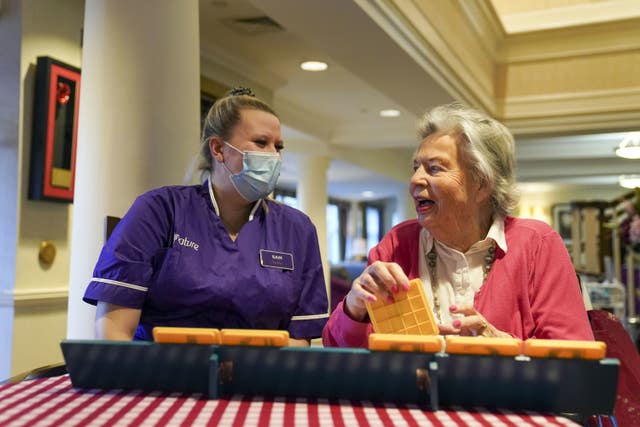Absolutely wonderful: Care home residents’ joy as visiting restrictions lifted
From Monday, those living in care homes in England are able to have unlimited visits from family and friends.

Care home residents are celebrating the lifting of restrictions on the number of visitors they can receive.
From Monday, those living in care homes in England are able to have unlimited visits from family and friends, the Government has said, meaning they will be able to reunite with loved ones they may not have seen for months.
Christine Rogers, 93, who lives at the Signature At Weybridge care home in Surrey, told the PA news agency the development was “absolutely wonderful”.
In recent months, residents have only been allowed three named visitors, plus an essential caregiver, and they saw each other while separated by a glass screen.
She said: “It was better than nothing, but not very satisfactory really, because you can’t really hear very well.”

Ms Rogers said she was looking forward to visits from her son, daughter, daughter-in-law and granddaughter, who always “bring all sorts of lovely things – flowers, always”.
“I tell them not to, I say it’s lovely to see them – you know, they don’t need to bring anything, but then they don’t take any notice.”
She also said she was looking forward to “catching up on all the gossip”.
The Government first announced the end of national restrictions on care home visits in November.
However, it then imposed the limit on visitor numbers when the Omicron variant hit.
John Cooke, 88, who also lives at the Weybridge care home, was on Monday reunited with his friend of 45 years, Val Gadd, 75, without needing to be separated by a screen and masks.

Mr Cooke said the lifting of the visitor rules was “very good” and meeting face-to-face was “much better”, adding: “Talking through glass is not necessarily the best way to meet.”
A senior care assistant at the home said the restrictions on visitors during the pandemic had taken a “massive toll” on residents.
Samantha Relff-Arnold, 24, said: “It’s been really upsetting for them to not be able to have their loved ones close by, especially when the times have been so tough.
“So comforting them has been a massive role and kind of being like their counsellors really, because we’re listening to their problems and helping them as best as we can, trying to be their loved ones and love them like their loved ones.”
She added: “I think everyone’s really excited to have the restrictions eased.”
Xenos Foster, 44, client liaison manager at the home, said: “The residents have been troupers.
“A lot of them were born in and around the Second World War, they know what real restrictions look like.
“But I mean it’s been a long 18 months and the fact that it is now easing up and the fact they can have anybody come in to see them as long as they provide a lateral flow test before they visit – you can just see that there’s an air of excitement about the place at the moment, which is great.”
The latest change, announced last week, means there are no nationally-set restrictions, but individual homes will continue to be able to set their own visiting policies.
While the news has broadly been welcomed, homes currently with outbreaks will not be able to lift restrictions immediately and there are concerns others may continue to restrict visits or not have enough staff to cope with an increase in visitors.
Jenny Morrison, co-founder of the campaign group Rights for Residents, says they “remain fearful” for residents in homes which have not followed previous guidance instructing them to relax visiting policies.

Health Secretary Sajid Javid acknowledged care homes have “a lot of discretion” over the rules they set, urging providers to do “everything they can to allow as many visitors as they can”.
He said: “If a care home needs to act differently because of an outbreak, then that is understandable as long as they are doing everything they can to allow the maximum number of visitors.”
Other changes include care homes only having to follow outbreak management rules for 14 rather than 28 days, and self-isolation periods will be cut from 14 days to 10 days for those who test positive – with further reductions if they test negative on days five and six.
Isolation periods for those in care following an emergency hospital visit are also being reduced from 14 to 10 days.
And staff will be asked to start using lateral flow tests before their shifts instead of weekly PCR tests from February 16.
In Scotland there is no set limit on the number of households visiting each resident indoors, but the group size should be risk-assessed to determine the number of visitors a resident can receive at any one time.
There is no prescribed limit for the number of indoor visitors a resident can have in Wales, while in Northern Ireland residents can receive up to four visits a week, from up to four visitors from two households per visit.





